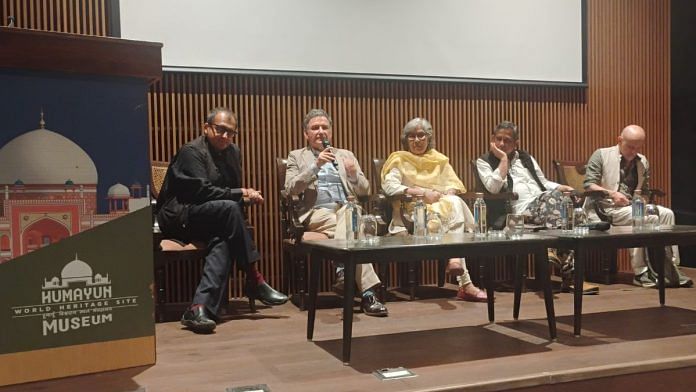New Delhi: The conservation of heritage sites is not just the protection of historical buildings but also ensuring the intangible heritage endures—people, the food, the culture.
Heritage sites such as Humayun’s Tomb or the Nizamuddin Basti nearby contain more than just old buildings, they carry the histories of the people still living in the neighbourhoods in the vicinity. Their families, their workplaces, and livelihoods intertwined with the Hazrat Nizamuddin Dargah.
“Conservation and protection as words, do not convey the dynamism and vitality behind this work. This is more than just the protection of a site, it is about being alive and giving continuity to life. You can do this, if you better understand your roots, which would allow you to care about the sites and the people,” said Andrea Anastasio, the director of the Italian Cultural Institute (IIC), on 26 March.
Anastasio was speaking at a talk on Heritage and Democracy organised by the IIC at the Humayun’s Tomb museum auditorium. The other speakers included filmmaker Milo Adami, Italian actor Giuseppe Cederna, Ratish Nanda, the CEO of the Aga Khan Trust for Culture (AKTC), Jyotsna Lall, director of programmes at AKTC, and Biraj Patnaik, the executive director of the National Foundation for India.
The conversation focussed on the role cinema could play in raising awareness on the protection of heritage sites, and brought together practitioners from both India and Italy. Two of Adami’s documentaries were also screened that captured the life of journalist and archaeologist Antonio Cederna—Giuseppe Cederna’s father—and his efforts in the protection of monuments in Rome.
“India had over 150,000 varieties of rice at one point. Today you find a handful of varieties left. There are still communities involved in protecting 600 to 700 varieties of rice, but there has been a far larger erasure of intangible heritage,” said Patnaik.
Cinema as a tool
Antonio Cederna, a trained archaeologist, gave up his career when he learnt that the Appian Way—one of Rome’s first strategic highways built over 2,300 years ago—was under threat in the 1950s. He focussed on journalism and wrote about how Rome, at the end of the World War II, was slowly being swallowed up by large apartments and vacation homes, raising concerns about the preservation of the city’s tangible monuments.
His first article published in 1953, titled The Gangsters of the Appian Way, raised the spectre of speculative housing markets surrounding the road and the damage they were doing to the city. Rome, today remembered for its historical monuments, be it the Colosseum, Trevi Fountain, or even the Castel Sant’Angelo, was in the 1950s an overcrowded city with no urban planning.
Cederna’s work in the protection of Roman monuments was converted into a number of documentary films by Adami and Giuseppe.
“Cinema is a very powerful language. Cinema speaks to the stomach, emotions and the head. Cinema is the most popular language in the arts. Images are what people look at the most. Cinema is able to bring the community together into a public square. Cinema is also a tool to better understand my culture,” said Adami.
Adami also worked with Giuseppe on Appia Antica and Mirabilia Urbis—the two documentaries shown at the discussion.
“A Mirabilia Urbis used to be a short Latin manuscript and books which described the monuments and historic sites for travellers centuries ago. For my father, this was his way of writing about the development of Rome,” explained Giuseppe.
Also read: Restoring Jaipur’s Jal Mahal took 5 yrs. Now it has 170 bird species
‘Not against progress’
Antonio Cederna’s efforts to protect the Roman sites find similarities with the efforts undertaken by the residents and civil society groups in New Delhi to restore Sunder Nursery. In the past, there were some plans of possibly creating a golf course, even a highway right through the heritage site.
“We know that in Delhi, we live in a city that traces history a millennia, which includes at least a thousand years of city building. We however, do not have much to show for it,” said Ratish Nanda.
He explained how the plans for the highway were dropped, but eventually resurfaced in 2014, and finally stopped after the six monuments in Sunder Nursery received the UNESCO World Heritage tag.
From the RWAs in Jor Bagh and Sunder Nagar, animal welfare organisations, to UNESCO, everybody wrote to the government to protect Sunder Nursery and Humayun’s Tomb.
For Andrea Anastasio, the question seen both in India and in Italy is one to “understand the plurality of voices in a democracy.”
“I am not against progress, I am against the stupidity of it,” said Antonio Cederna.
(Edited by Aamaan Alam Khan)






